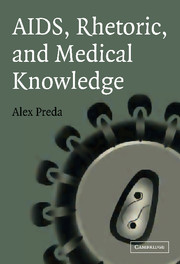Book contents
- Frontmatter
- Contents
- Acknowledgments
- List of Abbreviations
- Introduction
- 1 Making Up the Rules of Seeing
- 2 The Economy of Risk Categories
- 3 The Etiologic Agent and the Rhetoric of Scientific Debate
- 4 Retrovirus vs. Retrovirus
- 5 The Spatial Configurations of “AIDS Risk”
- 6 Who Is How Much?
- 7 In Lieu of a Conclusion
- References
- Index
5 - The Spatial Configurations of “AIDS Risk”
Published online by Cambridge University Press: 25 July 2009
- Frontmatter
- Contents
- Acknowledgments
- List of Abbreviations
- Introduction
- 1 Making Up the Rules of Seeing
- 2 The Economy of Risk Categories
- 3 The Etiologic Agent and the Rhetoric of Scientific Debate
- 4 Retrovirus vs. Retrovirus
- 5 The Spatial Configurations of “AIDS Risk”
- 6 Who Is How Much?
- 7 In Lieu of a Conclusion
- References
- Index
Summary
Scientific Knowledge, Space, and Rhetoric
Very recently, the notion of space has received increased sociological attention as part of a broader interest in artifacts and their role in the constitution of social order. Space is a key dimension of social life, which is structured around distinctions such as public vs. private spaces, spaces of production vs. consumption, natural vs. artificial spaces, and so forth. Space also lies at the core of the distinction between the natural and the social world, central for our self-understanding as social beings: according to this distinction, society occupies a space distinct from that of nature. The two realms do not overlap, nor are they completely disconnected, but rather they are contiguous.
The social world is spatially organized with the help of artifacts such as buildings, which stabilize social life and differentiate it according to classes of social activities (Gieryn 2000, 2002a, pp. 35–6; Prior 1992). The distinction between the social and the natural is spatially constituted. Therefore, the realm of the political has to operate with and refer to this distinction at the symbolic level: this happens in the case of state-built gardens and parks, which reconstruct nature in terms of political and cultural considerations (Mukerji 2002; Carroll-Burke 2002). Consequently, social institutions, as well as human agency, are seen as depending on these distinctions and on the social organization of space.
Against this background, it becomes relevant to explore the connections between space and the production of scientific knowledge.
- Type
- Chapter
- Information
- AIDS, Rhetoric, and Medical Knowledge , pp. 188 - 209Publisher: Cambridge University PressPrint publication year: 2004



